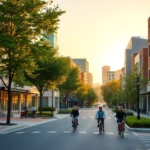Most dangerous cities in North Carolina: shocking hotspots revealed
- Why Knowing About Dangerous Cities in North Carolina Matters
- How Crime Data Works: Understanding the Numbers Behind the Headlines
- The Most Dangerous Cities in North Carolina: The Shocking Hotspots
- What Makes These Cities Risky? Exploring Root Causes
- Comparing Crime Rates: Most Dangerous vs. Safest Cities in North Carolina
- Real Stories from the Streets: Voices from North Carolina’s Risky Towns
- How to Stay Safe: Practical Advice for Navigating North Carolina’s Sketchy Cities
- The Role of Police and Community Programs in Fighting Crime
- What You Need to Know About North Carolina’s Most Dangerous Cities
- Sources and References
Why Knowing About Dangerous Cities in North Carolina Matters
Knowing about the most dangerous cities in North Carolina is crucial whether you’re thinking about moving, traveling, or just curious about safety in different parts of the state. Crime impacts daily life in many ways—from the streets you walk on, the neighborhoods you visit, to the buildings, cars, signs, and lights you see around you. Understanding which areas have higher chances of incidents helps you avoid risky spots and make smarter decisions for you and your family.
Many people describe certain areas as “sketchy,” “rough,” or “dodgy,” and these terms often come up in conversations about places to avoid, especially at night. This article is your go-to guide to those risky places in North Carolina, offering straightforward, no-nonsense info that everyday Americans appreciate. Whether you’re a young adult, a parent, or a student, knowing about these cities can help you stay safe and aware.
How Crime Data Works: Understanding the Numbers Behind the Headlines
Crime data in North Carolina comes from various sources, including FBI statistics, local police reports, and community input. These numbers help paint a picture of safety but can be tricky to interpret. Not all crimes get reported, and differences in policing or community trust can affect the data. For example, some neighborhoods might have less crime but also less reporting, while others might show higher numbers simply because of more active policing.
Key terms to know include:
- Violent crime: offenses like murder, assault, robbery, and rape.
- Property crime: burglary, theft, and motor vehicle theft.
- Crime rate per 100,000 people: a way to compare crime fairly between cities of different sizes.
But numbers alone don’t tell the full story. A city’s “dangerous” label often involves gang activity, drug problems, and poverty levels. These factors create rough neighborhoods where residents and visitors alike need to be cautious. So, it’s important to look beyond raw data and understand the real-life context behind the stats.
The Most Dangerous Cities in North Carolina: The Shocking Hotspots
| City | Violent Crime Rate (per 100,000) |
Property Crime Rate (per 100,000) |
Murder Rate (per 100,000) |
Robbery Rate (per 100,000) |
Assault Rate (per 100,000) |
Drug-Related Crime Notes |
|---|---|---|---|---|---|---|
| Lumberton | 1,200 | 2,500 | 15 | 120 | 600 | High drug trafficking, linked to violent incidents |
| Albemarle | 950 | 1,800 | 10 | 90 | 450 | Property crimes tied to economic hardship |
| Reidsville | 900 | 1,700 | 8 | 85 | 430 | Gang presence reported in some neighborhoods |
| Rockingham | 850 | 1,600 | 7 | 80 | 420 | Incidents of robbery and assault rising |
| Gastonia | 800 | 1,550 | 6 | 75 | 400 | Drug-related arrests increasing |
| Whiteville | 780 | 1,500 | 12 | 70 | 390 | Notable spike in violent crime recently |
| Greensboro | 750 | 1,450 | 5 | 65 | 380 | Some neighborhoods considered dicey after dark |
| Fayetteville | 730 | 1,400 | 7 | 60 | 370 | High gang-related crime in certain areas |
| Henderson | 700 | 1,350 | 4 | 55 | 360 | Property crimes linked to poverty |
| Durham | 680 | 1,300 | 9 | 50 | 350 | Violent crime hotspots in some neighborhoods |
Lumberton tops the list with a violent crime rate that’s notably high, mostly tied to drug trafficking and related violence. Locals often mention “sketchy” streets with poor lighting and less police presence at night. Albemarle and Reidsville face challenges with property crimes and gang activity, making some neighborhoods feel “janky” or “dicey.”
In Greensboro, residents warn about certain “rough neighborhoods” where assaults and robberies spike after dark. Fayetteville has areas known for gang-related crime, impacting schools and local businesses. Durham and Gastonia also report increased drug-related offenses, affecting community safety.
These cities show how crime affects everyday life—people feel less safe walking streets, some businesses close early, and community events sometimes get canceled. Signs of trouble include poorly lit streets, abandoned buildings, and suspicious activity around certain blocks.
Crime Rates in North Carolina's Most Dangerous Cities
Lumberton
High drug trafficking, linked to violent incidents
Albemarle
Economic hardship, property crimes
Reidsville
Gang presence reported
Rockingham
Robbery & assault rising
Gastonia
Drug-related arrests up
Whiteville
Violent crime spike
Greensboro
Dicey neighborhoods after dark
Fayetteville
Gang-related crime areas
Henderson
Property crimes linked to poverty
Durham
Violent crime hotspots
What Makes These Cities Risky? Exploring Root Causes
Many of the cities with high crime in North Carolina share common root causes. Poverty and unemployment are major factors, creating economic hardship that often leads to increased property and violent crimes. When jobs are scarce and opportunities limited, some residents turn to illegal activities like drug trafficking or gang involvement.
Drug activity plays a big role in making neighborhoods “unsafe places.” Areas with active drug markets often see spikes in violent crime and robberies. Local law enforcement reports confirm that many incidents are linked to these issues, especially in cities like Lumberton and Fayetteville.
Community leaders and residents often describe these places as “messed-up” or “gnarly” due to the combination of economic struggles and crime. One community organizer shared,
“We’re working hard to bring jobs and youth programs here, but the challenges are real. Without opportunities, it’s tough to keep kids away from gangs and drugs.”
Policing strategies vary, with some departments focusing on community engagement and others on tougher enforcement. Both approaches aim to reduce crime, but challenges remain, especially in neighborhoods with less trust between residents and police.
Comparing Crime Rates: Most Dangerous vs. Safest Cities in North Carolina
| City | Violent Crime Rate | Property Crime Rate | Community Safety Notes |
|---|---|---|---|
| Lumberton | 1,200 | 2,500 | High drug activity, gang presence |
| Albemarle | 950 | 1,800 | Economic hardship, property crimes |
| Pinehurst | 120 | 300 | Strong community involvement, low crime |
| Whispering Pines | 100 | 280 | Good policing, stable economy |
| Davidson | 90 | 250 | Safe neighborhoods, active watch programs |
| Waxhaw | 85 | 240 | Low crime, family-friendly |
| Elon | 80 | 230 | College town with good security |
Safer cities like Pinehurst and Davidson stand out because of strong community involvement, better policing, and economic stability. These places have fewer “dodgy spots” and more neighborhood watch programs, making them attractive for families and students.
If you’re visiting or moving, watch for signs of trouble such as poorly lit streets, abandoned buildings, or groups of suspicious people. Avoiding these “trouble areas” can help keep you safe.
Real Stories from the Streets: Voices from North Carolina’s Risky Towns
“I’ve lived in Greensboro for years, and while most of the city is fine, some neighborhoods at night feel really unsafe. The police do patrol, but there are still incidents on certain streets.” – Reddit user r/gso
“In Lumberton, drug activity is a big problem. Locals warn visitors to avoid some areas after dark because of recent robberies and assaults.” – Local news report, Protect Your Legal Rights
“Community programs in Fayetteville are trying to change things, but it’s slow. We need more jobs and youth activities to keep kids off the streets.” – Community leader interview, Property Club NYC
These firsthand accounts show the human side of crime statistics. People living in these “hardcore hoods” share concerns about safety but also hope for improvements through community efforts.
Staying safe in North Carolina’s riskier cities means being aware and prepared. Here are some practical tips:
- Avoid walking alone at night in poorly lit or unfamiliar neighborhoods.
- Watch for signs of trouble: suspicious cars parked for long periods, groups loitering near shady buildings, or streets with little police presence.
- Know your rights when interacting with police and always stay calm.
- Use neighborhood watch programs and community resources to stay informed.
- Check apps and websites for up-to-date crime alerts before visiting new areas.
- If you’re ever charged with a crime, having a reliable criminal defense attorney is crucial.
Being cautious and informed can reduce your chance of becoming a victim. Remember, even in cities with higher crime rates, many neighborhoods are safe and welcoming.

The Role of Police and Community Programs in Fighting Crime
Local police departments in North Carolina work hard to tackle crime in “messed-up” or “janky” neighborhoods. Many have launched community policing initiatives that build trust and encourage residents to report suspicious activity.
Community programs also play a big role. Youth outreach, job training, and neighborhood cleanups help reduce crime by addressing root causes. Police chiefs often note the challenges they face, such as limited resources and community mistrust, but emphasize ongoing efforts to improve safety.
One police chief said,
“We’re committed to working with residents to make our neighborhoods safer. It’s a team effort that requires everyone’s involvement.”
Getting involved in local safety efforts, like attending town meetings or joining watch groups, can make a real difference.
What You Need to Know About North Carolina’s Most Dangerous Cities
To sum up, the most dangerous cities in North Carolina include Lumberton, Albemarle, Reidsville, and others where crime rates are notably higher than the state average. These cities face challenges like poverty, gang activity, and drug trafficking, which contribute to “rough neighborhoods” and “unsafe places.”
However, crime can happen anywhere, so staying informed and cautious is key. Safer cities like Pinehurst and Davidson show how community involvement and economic stability help keep crime low.
Use this information to make smart choices about where to live, visit, or invest. Knowledge is power when it comes to safety.
Sources and References
- Protect Your Legal Rights - NC Crime Rate by City
- Property Club NYC - Most Dangerous Cities in NC
- FBI Crime Data - North Carolina
- Doug Edwards Law - NC Crime Rate by City
- Reddit - Greensboro Crime Discussion
- Atlas Award - Top 5 Dangerous Cities in NC
- 247 Wall Street - NC Cities with Most Gun Crime
- Norada Real Estate - Worst Places to Live in NC
What do you think about the safety situation in North Carolina’s cities? Have you experienced any “sketchy” or “risky” neighborhoods? How would you like to see communities improve safety? Share your thoughts, questions, or stories in the comments below!
 Safest cities in North Carolina: surprising top spots revealed
Safest cities in North Carolina: surprising top spots revealed Top violent cities in North Carolina: shocking crime hotspots revealed
Top violent cities in North Carolina: shocking crime hotspots revealedSi quieres conocer otros artículos parecidos a Most dangerous cities in North Carolina: shocking hotspots revealed puedes visitar la categoría North Carolina.

Leave a Reply